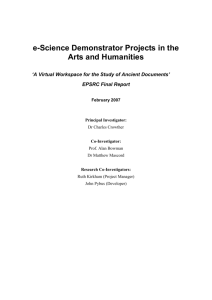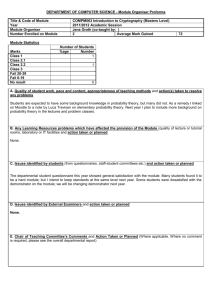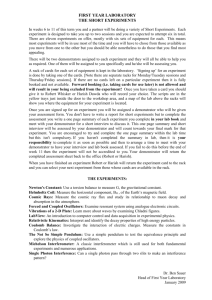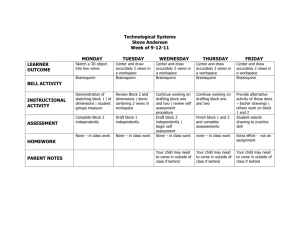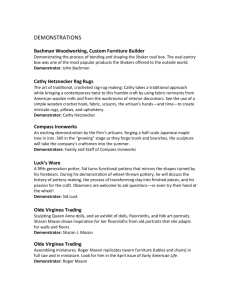Proposal - A Virtual Workspace for the Study of Ancient
advertisement
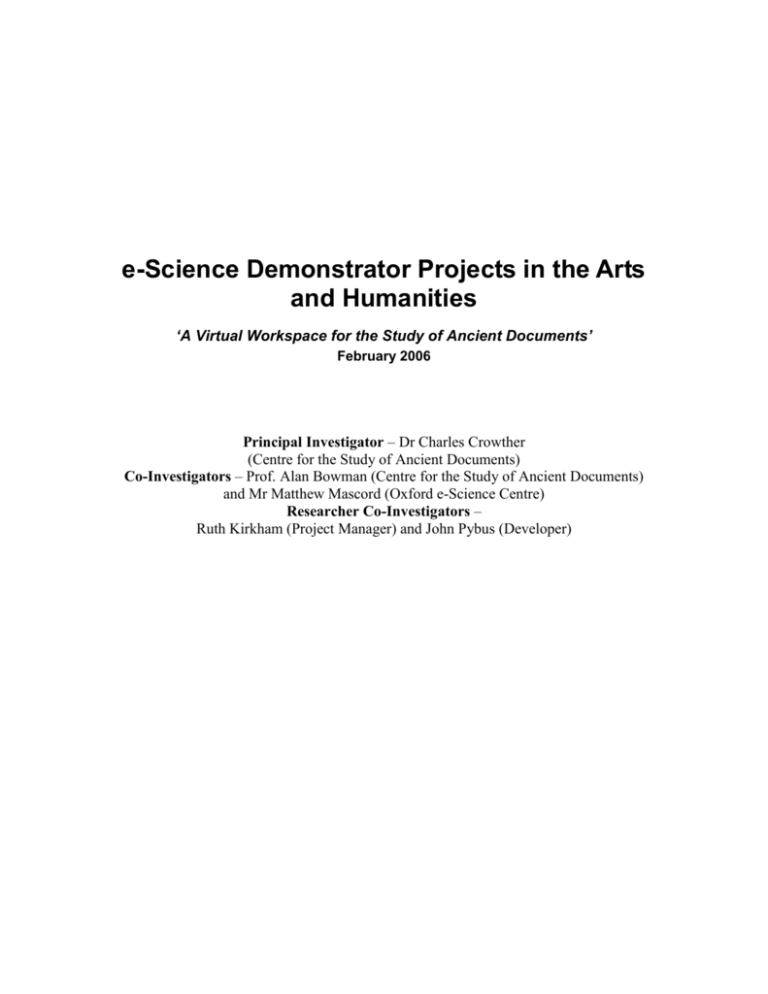
e-Science Demonstrator Projects in the Arts and Humanities ‘A Virtual Workspace for the Study of Ancient Documents’ February 2006 Principal Investigator – Dr Charles Crowther (Centre for the Study of Ancient Documents) Co-Investigators – Prof. Alan Bowman (Centre for the Study of Ancient Documents) and Mr Matthew Mascord (Oxford e-Science Centre) Researcher Co-Investigators – Ruth Kirkham (Project Manager) and John Pybus (Developer) Introduction and background The proposal to construct a ‘Virtual Workspace for the Study of Ancient Documents’ is submitted with the intention that it should offer a paradigm for methodological approaches to particular types of research resources. These resources are characterised by the fact that the physical objects of research are in widely dispersed locations; for interactive participation by researchers working in dispersed environments; for interdisciplinary approaches to humanities research; and for the creation of a set of deliverables which are primarily determined by the needs of the users (i.e. the researchers). Because a great deal of humanities research is directed towards written evidence of one kind or another and because this is where the expertise of our own research group is focussed, we propose a demonstrator that specifically addresses the needs of research on ancient documents, but deploys technologies that are likely to be applicable across other disciplines in which textual analysis is important. Ancient documents should be understood as including texts of different kinds written on a variety of media: manuscripts, inscriptions on stone, wooden and lead writingtablets, papyri and parchments, graffiti etc. Much of this material has been removed from original contexts and scattered across university and museum collections throughout the world. Researchers have in the past been accustomed to extensive travel to consult original texts or to being content with facsimiles (where available) of varying quality and cost. The potential of ICT to address these and similar issues in documentary scholarship was understood at an early stage and has been exploited by a number of projects. Images of large numbers of documentary texts have been made available; extensive (in some cases, comprehensive) text databases, bibliographies, lexica, thesauri and other analytical tools have been developed. As a result, the scholar interpreting an ancient documentary text now has a broad range of relevant electronic tools available; but the interaction is largely in one direction and the experience is fragmented by the dispersal of the electronic resources. The potential of ICT to mediate collaborative activities has also yet to be fully exploited. Decipherment and transcription are activities that naturally benefit from shared visualisation and multiple perspectives. Collaborations at present are conducted by correspondence interspersed with occasional personal meetings and still more occasional confrontations between researchers and original source materials. Developments in e-Science have opened new possibilities to make collaborative work on decipherment and analysis available on demand to researchers. The proposed demonstrator project will construct a virtual workspace for research involving decipherment and textual analysis of damaged and degraded ancient documents written mainly on papyrus, wood and stone. It will provide direct access to widely scattered research resources (dictionaries, corpora of texts, images of original documents etc.), to computing power needed to enable the researcher to work with them, and in collaboration with other researchers in remote locations, in a fully integrated environment. Early indications of an extensive user requirements survey carried out by the 'Building a Virtual Research Environment for the Humanities' (BVREH) project has detailed a desire for such a tool and that there are clear needs to be addressed. Aims and Objectives: 1. To deliver a working system that will enable a researcher to: Search across multiple, distributed data sets, images and text Select, store and organise items from the above, in a ‘personal workspace’ Add annotations to these items to store personal thoughts and responses Support collaboration by allowing multiple researchers in separate locations to share a common view of the workspace, in conjunction with real time communication via Chat, VoIP and desktop integration with AccessGrid Allow a collaborator to comment, point/highlight, discuss and annotate the items in the shared workspace 2. The project aims to demonstrate the incremental advantages of assembling existing ITC resources for research into ancient documents within a virtual workspace which would also allow researchers to share images and annotations with colleagues and work in real time with remote collaborators. This demonstrator forms a step towards the creation of an environment offering a ‘dynamic assembly of knowledge’ in which a researcher can: Access high-quality images of documents in remote locations which have not been hitherto available to him or her Reassemble individual documents which have been fragmented and dispersed and, as far as possible to reconstruct their original context Compare and collate related documents or corpora of texts Access all the bibliographical and other research tools necessary for understanding the document Use sophisticated IT tools and applications which allow the user to manipulate texts and images, in particular to enhance the images of damaged, abraded and otherwise illegible texts to the point where they can be read Communicate with other researchers virtually, in an environment which allows direct consultation and interaction between documents and scholars Collate and publish drafts of texts which can be linked to images of the original documents and made widely available to scholars and the general public where appropriate Enhance the environment by contributing his or her own tools, knowledge and data for use by other scholars (subject to normal constraints of copyright, intellectual property etc.) Methodology Researchers into ancient documentary sources draw on an extensive, but disparate range of specialist scholarly electronic tools and data sources which are both accessible through the web and under continuous development: - The Thesaurus Lingua Graecae (TLG) - Lexicon of Greek Personal Names (LGPN shortly to be fully available as an XML database) - Advanced Papyrological Information System (APIS) - Duke Databank of Documentary Papyri (DDBDP: all Greek documentary papyri) - The Packard Humanities Institute Greek Epigraphy Project (c. 80% of published Greek inscriptions) - Electronic L'Annee Philologique - Claros Concordance of Greek Inscriptions - Perseus (including online edition of LSJ Greek Lexicon) - Epigraphische Datenbank Heidelberg (EDH: c. 35,000 Roman inscriptions); complemented by the Epidoc initiative which has generated online editions of the Vindolanda writing tablets (http://vindolanda.csad.ox.ac.uk) and the inscriptions of Aphrodisias (http://www.insaph.kcl.ac.uk/) It is with items of data from the above sources that the researcher will populate their ‘personal workspace’. By utilising web services to link datasets, we will form the start of a DataGrid for ancient documents which can be cross searched through a single easy to use interface. The collection of items that form the personal workspace will be stored by reference to their position in the original data source, along with the metadata, describing both the item and the annotations in an RDF triple store. The intention is to utilise the schemas and protocols introduced by Annotea [1] to describe the annotations. We intend that the collaborative front end will make use of image display and analysis components already available from the ‘Virtual Lightbox’ [2] project which is suitable to embed in a web accessed environment. Programme of work and required resources Working closely with the Principal Investigator and researchers in the study of ancient documents the team will draw upon knowledge gained during the user requirements survey within the VRE project. It is anticipated that valuable knowledge will be gained from workshops designed to create a humanities based user requirements community, proposed by the BVREH project in answer to the AHRC research workshop call. Having recently completed an assessment of existing tools and technologies within the BVREH project, together with knowledge and collaboration with other VRE projects across the country, the team will be well placed to make decisions on the suitability of technologies. There will be particular focus on ensuring that the demonstrator is built on foundations which benefit both the functionality of the prototype and which enables extensibility and re-usability of the virtual workspace. Working directly with the users within the CSAD, the project will begin by agreeing a detailed design for the user interface to the demonstrator. Development work will continue to be informed by ongoing user testing ensuring that the ‘Virtual workspace’ is focused on the researchers needs throughout the project. The initial phase of the development work will be to integrate existing tools such as the VLMA, Annotea server/RDF Triple Store and the interface to the selected datasets of ancient documents. Development will also include the construction of an initial version of the user interface which can be presented to the user community for testing and this process will be iterated to form the final system which will be deployed. The project will purchase a new computer server system onto which these tools will be deployed. Concurrently, the necessary interaction with holders of datasets will be required to facilitate the smooth integration of these sources within the demonstrator. Throughout the project research to analyse the extensibility of the demonstrator and its applicability to the wider research community will be carried out and this will be presented in the final report. As the project is creating a tool for use by researchers at widely spread sites, some funds will be required for travelling expenses, including visits to the holders of datasets which will be included in the demonstrator. The breakdown of work between team members will be as follows: John Pybus (Developer) will undertake all development work, including involvement with ongoing user testing which will inform the development. He will be responsible for deploying the Virtual Workspace prototype at the end of the project and will take an active part in demonstrating the work to users and interested parties. Ruth Kirkham (Project Manager) will be responsible for the day to day running of the project, including administration, organisation, report writing and dissemination. The Project Manager will take an active role in all stages of user testing and will carry out work to identify sources of research material, establishing the links and wider audience for the projects outcomes and conducting a survey as to the likely extensibility of the demonstrator. The principal applicant, Dr Charles Crowther will undertake to oversee the organisation of the project, the planning, structure and execution of the constituent parts of the project plan. Dr Crowther and Professor Alan Bowman will have significant, detailed input into the initial design process to ensure that the tool built, fully conforms to their research methodology. Mr Matthew Mascord, as Co-Investigator, will collaborate on all aspects of the underlying infrastructure which will form the ‘ancient document DataGrid’. The project will also benefit from continuing interaction and support from the BVREH steering committee and principal investigators. Timeliness and novelty of project The application for support to construct this demonstrator is particularly timely because it fits very well into the context of development in Interdisciplinary e-Science at Oxford and nationally. It also contributes to progress on research in national collections of documents, which is an important aspect of the work of the National Archive in Britain and has been emphasised as a central component of ‘national heritage’ in recent EU cultural programmes and is complementary to projects such as the Rinascimento Virtuale http://www.rrz.uni-hamburg.de/RV/. The demonstrator will also exploit the user requirements work carried out by the BVREH project both in Oxford and more broadly. The current VRE project is keen to establish a requirements capturing community within the humanities and has submitted a proposal to the AHRC Workshop call accordingly. For the Virtual Workspace, the user requirements work is particularly timely and the demonstrator will benefit greatly from the work already undertaken. Beneficiaries The following, is taken from an account by Dorothy Thompson of her response to the digitisation of an important demotic papyrus from Rifeh, now in University College, London. In 1996 the papyrus was brought to the CSAD to be scanned and digitised. Previously the text had only been readable through the use of a magnifying glass with many days spent poring over the text. Once the papyrus had been scanned, the team of papyrologists assembled in front of a computer to see what benefits digitisation might bring. Far from the barely legible original, the images on screen made the “script come to life” and readings and suggestions from the group flowed freely leading the author to conclude: “I have seen the future and this future works - at least so far. Work in different countries on the same text at the same time can now take place without problem and for a long and difficult text, where the writing is small and faded, the possibility of working on the image on the screen is in itself a great advance.”[3] This enthusiastic response details how advances in technology and digital imaging are considerably enhancing research in the field of ancient documents. Not only do the texts become more legible, but age old problems of time and access are significantly reduced. Whilst the above scenario describes a number of researchers travelling to the CSAD to gather around a single computer screen, the ‘Virtual Workspace’ will take the possibilities further and will enable the author’s vision of the future to become a reality. To “Work in different countries on the same text” simultaneously will allow researchers to collaborate, forming a ‘virtual gathering’ without being unnecessarily constrained by time, money or travel. With the creation of an ‘ancient document Datagrid’, the dispersed community will be able to cross-search and crossreference a broad range of documents and images, share their thoughts and make suggestions for readings in an environment which reflects and encourages the collaborative nature of the work. The Virtual Workspace will service and mediate the flow of work through the research cycle, from the capture of primary data through decipherment, initial analysis and identification of comparanda, discussion and review with colleagues and collaborators, to reintegration of acquired knowledge and its application to new primary data. Dissemination and Exploitation The dissemination of the outcomes of the project will take various forms. The demonstrator will be continuously user tested throughout the three months of the project both within Oxford and externally by researchers and data providers. Once complete the project team will undertake to showcase the demonstrator at relevant conferences and seminars including the ‘Digital Resources for the Humanities’ 2007 and the ‘International Congress of Greek and Latin Epigraphy’ September 2007. The project reports will be published on the BVREH and the CSAD websites and the outcomes will be embedded in the Oxford Humanities VRE and widely disseminated to the wider VRE community, through research centres such as the AHRC Methods Network (KCL) and the Oxford Interdisciplinary e-Research Centre. It is also envisaged that a paper describing the project will be published in a scholarly journal such as Zeitschrift für Papyrologie und Epigraphik. References: [1] Annotea reference (http://www.w3.org/2001/Annotea/) [2] Virtual Lightbox reference (http://lkws1.rdg.ac.uk/vlma/vlma.htm) [3] The full account can be found at http://www.csad.ox.ac.uk/CSAD/Newsletters/Newsletter2/Newsletter2a.html.

